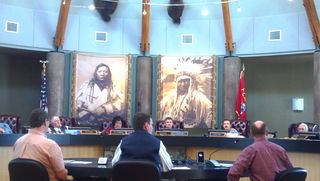
by Jennifer Perez Cole, public affairs/outreach specialist, Montana Farm Service Agency
Montana’s USDA agency directors met with seven tribal councils in February and March to update them on programs and services and identify ways USDA agencies can better serve tribal communities. This was the third set of government-to-government meetings since 2009.
Improving access and delivery of USDA programs and services for tribal communities and Native Americans and strengthening relationships with tribal leaders are national priorities of USDA and of the State Food & Agriculture Council (SFAC) in Montana.
“It’s important for us to hear directly from tribal leaders on how USDA can better serve Indian Country,” said Dick Deschamps, acting state executive director of Montana Farm Service Agency. “Face-to-face communications such as we were able to hold over the last months coupled with the implementation of a State Food and Agricultural Council strategic plan for USDA doing business with Indian people and Montana tribes will aid us greatly in our commitment to serve.”
Tribal lands encompass 9 percent of Montana’s 147,046 square mile land base while Native Americans represent about 7 percent of the state’s population.
As USDA programs change through evolving farm bills, it is a continuous process of educating the public, including Native Americans and tribes, about the availability and regulations of USDA programs. The national USDA Office of Tribal Relations is addressing this through a nationwide five-year technical assistance contract with Intertribal Agriculture Council (IAC) to help improve access and use of USDA programs and services by Native Americans, tribes and tribal organizations.
Montana is doing the same by addressing priority and long-term challenges and opportunities on tribal lands through a five-year statewide USDA Tribal Strategic Plan that will focus on housing shortages and public infrastructure needs, grasshopper and prairie dog control, invasive species, livestock and human safety from predators such as wolves and grizzly bears and the need for public education about overgrazing of rangeland.
Montana teamed up with Intertribal Agriculture Council and the Indian Nations Conservation Alliance to work directly with tribal governments this spring to develop a strategic plan. This process will identify programs and services to meet specific conservation, agricultural, public facilities and other needs in Indian Country. The plan also will help implement action plans and accomplish increased services to tribal communities and individuals.
At the direction of President Obama, Agriculture Secretary Tom Vilsack has made improving relations with Native American Tribes a priority. In 2009, Vilsack launched the Office of Tribal Relations and directed all USDA agencies to engage in tribal consultation and collaboration.





